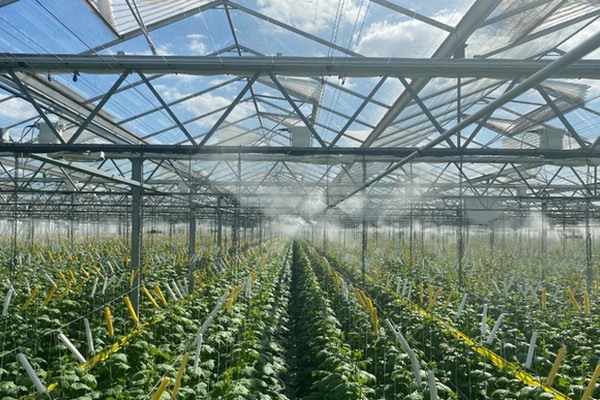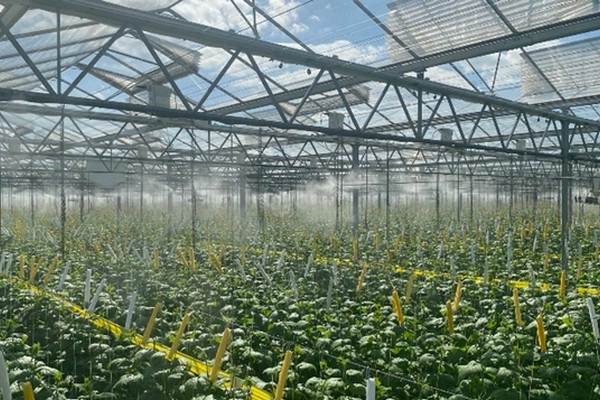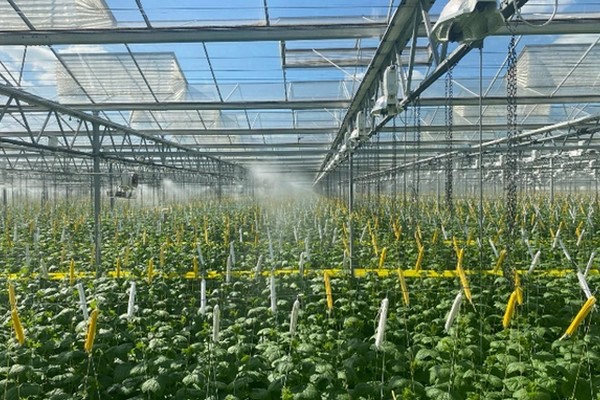Fresh Valley grows cucumbers, mini-cucumbers, tomatoes, cluster cherry tomatoes, and strawberries in their greenhouses in Uden, Boekel, Sevenum, Maasbree, and Grubbenvorst, the Netherlands. The facility at Bovenstehuis in Boekel (6.1 hectares) is equipped with high-pressure fogging by MJ-Tech and insect netting from Holland Gaas, supplied via Alweco. The grower René Tielemans shares more about the use of both technologies.
A central climate computer controls the MJ-Tech high-pressure fogging system. When a moisture deficit below the defined setpoint is detected, the high-pressure fogging unit starts to add moisture to the greenhouse. This does not depend on the relative humidity as the moisture deficit indicates how many grams/m³ of moisture can be added to the air.
"This is a safe way to control the greenhouse climate," explains Rob Kwinten from MJ-Tech. "With a high moisture deficit and a high temperature, the plant stomata close, and photosynthesis stops. If the moisture deficit gets too high, CO2 dosing in the greenhouse also stops. All of that can be prevented by simply lowering the moisture deficit through high-pressure fogging. In this way, the plant can maximize the absorption of the provided CO2 and sunlight."
The amount of moisture that can be introduced - the pulse length - depends on the available solar radiation and the air exchange capacity of the greenhouse. "This allows us to respond quickly to changes in the external climate. With high-pressure fogging, we create exactly the climate plants need to continue to evaporate optimally."

Insect Netting
The greenhouse has a 0.4x0.4 mm mesh to keep insects out of the greenhouse. Holland Gaas reports that thanks to the netting of the greenhouse, only 10% of the insects enter the facility, while 90% stay out. Holland Gaas can produce any mesh opening, but it's important to find a balance between reducing insects and providing proper ventilation. René has noticed this too. "Where previously pest insects flew in all at once, we can now effectively control them with biological control. By using insect netting, we reduce unpleasant surprises from occurring in the crop." This is especially important considering growers can rely on a very limited number of chemical products, whose effectiveness has even decreased over time. As a response, growers resorted to different solutions to keep pests away, or any other animals for that matter. For instance, sparrows can carry the cucumber mosaic virus, and it goes without saying, that growers do not want that risk to their crops.

Spider Mites
René uses predatory mites to combat spider mites and keep pest pressure in the greenhouse low. The insect netting makes it much harder for thrips to enter the greenhouse, and high-pressure fogging supports the biologicals: at high humidity and lower temperature, the population of predatory mites is more active and fare better populated overall. "Previously, biologicals were mainly active in the lower part of the plant, where it is more humid and cooler. With high-pressure fogging, we see predatory mites are also getting to the top of the plant. This results in less crop damage and biotic plant stress." At the same time, biologicals are not the only ones benefitting from it, as a cooler climate in the greenhouse is also desirable for farmworkers during warm periods.
Ventilation Strategy
Growing with insect netting also required some adjustments to the ventilation strategy. "Previously, a few percent of venting was enough for air exchange in the greenhouse. After the installation of the insect netting, a few percent more had to be added," René explains. The combination of high-pressure foging and insect netting results in fewer fluctuations in the greenhouse climate and a healthier and more vibrant crop. Last week, fogging was also used to create a vegetative climate to facilitate the formation of new tops.

Fog and Screens
Because high-pressure fogging and screens are used, there is no need to use chalk on the locations anymore. "Since the installation of high-pressure fogging, the screens close later. This allows for up to 150 W/m² more solar radiation to be received during warm periods," René says, referring to the rule: 1% more light equals 1% more yield. Thanks to the provided moister, the stomata also remain open during warm periods. This is reflected in the water uptake, which is monitored with scales. Also, the leaves do not wilt, which maximize light absorption.
Growers share information about the application of high-pressure fogging and insect netting by participating in study clubs. There also came a practical tip from René. "Install the insect netting before you install high-pressure fogging. This way, there is more workspace for the installation of the insect netting." Holland Gaas adds that the netting systems can be mounted from both the outside and the inside.
For more information:
Fresh Valley 
Tel: 0777820170
[email protected]
www.freshvalley.nl
Holland Gaas
Tel: +31 174 516 180
[email protected]
www.hollandgaas.nl
MJtech
Tel +31 (0) 76 597 45 03
[email protected]
www.mjtech.nl
